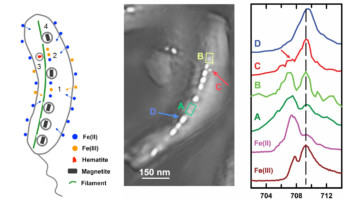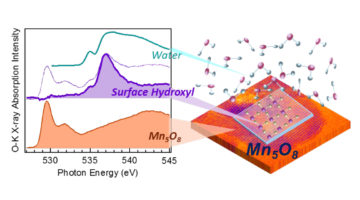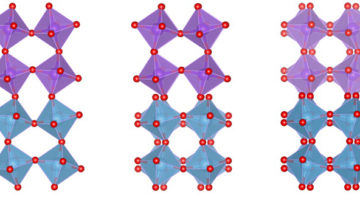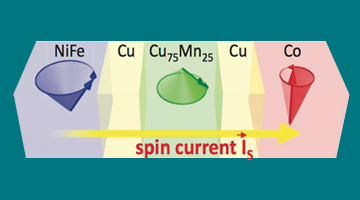Researchers used x-ray fluorescence, spectroscopy, and diffraction to study how populations of symbiotic bacteria can act as a detox organ in a host with no organs. The bacteria, members of the species Entotheonella, accumulate and mineralize large quantities of arsenic and barium in sponges. Read more »
ALS Work Using XAS
In x-ray absorption spectroscopy (XAS), the incident x-ray energy is tuned over a range that will excite core-level electrons. Sharp increases in absorption occur at specific energies, characteristic of the absorbing element. The resulting spectra probe the elemental composition as well as the chemical and electronic structure of the material.
Ptychography of a Bacterium’s Inner Compass
Magnetotactic bacteria (MTB) synthesize chains of magnetic nanocrystals (magnetosomes) that interact with the Earth’s magnetic field like an inner compass needle, simplifying their search for optimum environments. Ptychographic spectra of magnetosomes from a marine MTB provides insight into how these inner compasses form. Read more »
For Better Batteries, Open the Voltage Window
Electrochemical (battery) cells with aqueous electrolytes can be safe, inexpensive, and environmentally friendly, but they are limited by a narrow voltage window. X-ray absorption spectroscopy helps explain why an aqueous Na-ion system with Mn5O8 electrodes has a large voltage window and performs comparably to Li-ion batteries. Read more »
Magnetism Emerges at Wonky Interfaces
Researchers have found a new way to control magnetism at the atomic level that will serve as a model for studying emergent phenomena in other systems. The ability to engineer and tune properties on such small length scales can (eventually) enable us to design exciting new magnetic devices. Read more »
Exploring the Structure of Aqueous Solutions with SALSA
Researchers have published a series of papers that open up the possibility of probing hydrogen bonds in aqueous solutions by combining x-ray emission spectroscopy and resonant inelastic soft x-ray scattering, using the specialized Solid and Liquid Spectroscopic Analysis (SALSA) endstation at Beamline 8.0.1. Read more »
Scientists Trace ‘Poisoning’ in Chemical Reactions to the Atomic Scale
A team of researchers has employed a combination of measurements, including x-ray experiments at the ALS, to gather the most detailed information yet on problematic carbon-based deposits called “coke,” and to find ways to prevent its formation or reduce its effects. Read more »
Understanding Barriers to Higher-Capacity Rechargeable Batteries
Vanadyl phosphate can theoretically accept twice the number of lithium ions as battery materials currently in use. In practice, however, it doesn’t live up to expectations. New research at Beamline 6.3.1 using a variety of hard and soft x-ray spectroscopies helps zero in on why. Read more »
How to Directly Probe ac Spin Currents
Scientists working at the ALS have made the first unambiguous, direct measurements of ac spin currents flowing through nanostructured metal layers. The work represents a crucial step toward the development of future spintronic devices that are smaller, faster, and more energy efficient. Read more »![]()
![]()
A Conscious Coupling of Magnetic and Electric Materials
Scientists have successfully paired ferroelectric and ferrimagnetic materials so that their alignment can be controlled with a small electric field at near room temperatures, an achievement that could open doors to ultralow-power microprocessors, storage devices and next-generation electronics. Read more »
A Surface Treatment for Improving Fuel-Cell Cathodes
Solid-oxide fuel cells (SOFCs) are a promising path toward the “clean” conversion of chemical energy to electrical energy with little or no carbon dioxide emission. With the help of the ALS, researchers from MIT recently found a way to treat SOFC cathode surfaces so that they perform better and last longer. Read more »![]()
![]()
- « Previous Page
- 1
- …
- 6
- 7
- 8
- 9
- 10
- Next Page »









